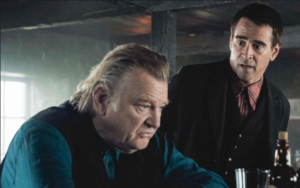THE BANSHEES OF INISHERIN: 4 STARS. “Come for the cussing, stay for the performances.”
 Fifteen years ago, director Martin McDonagh brought actors Colin Farrell and Brendan Gleeson together as inept hitmen in hiding in the Belgium-set film “In Bruges.”
Fifteen years ago, director Martin McDonagh brought actors Colin Farrell and Brendan Gleeson together as inept hitmen in hiding in the Belgium-set film “In Bruges.”
Sparks flew.
The terrific trio reunite in “The Banshees of Inisherin,” a new movie, now playing in theatres, that locates the setting to a tiny Irish island, but maintains the chemistry that made “In Bruges” an audience and critical favorite.
Set in 1923 on a windswept island off the west coast of Ireland, the story begins as the Irish Civil War rages on the mainland. With the sounds of gunfire and exploding bombs in the distance, village nice-guy Pádraic (Farrell) goes about his daily routine, stopping by his life-long friend Colm’s (Gleeson) house to collect him on the way to the pub. When his knock at the door goes unanswered, Pádraic peers through the window to see his old friend, sitting and smoking, ignoring the rapping at the door.
Later at the pub, the gormless Pádraic learns why he was snubbed by Colm. “I just don’t like you no more.”
Hurt and confused, Pádraic attempts to patch things up, but Colm is steadfast. He wants to spend his remaining time, no matter many years he has left, doing something meaningful; not making small talk over a pint. Pádraic is dull, Colm says, his conversation a waste of time.
Despite the threat of dire consequences, Pádraic cannot accept that the friendship is over, and what began as a cold shoulder escalates into violence born of humiliation and anger.
The darkly hilarious “The Banshees of Inisherin” uses Colm’s brushoff of his former friend as the engine to drive a universal story of loneliness, what happens when civility fades and the importance of support systems.
McDonagh creates a vivid backdrop for the action. Life on the small island is presented as simultaneously idyllic and stultifying. The rolling hills, greenery and winding country roads are straight out of a tourist brochure. But it’s the soft underbelly, the stuff that lies beneath the quaint façade, that is of interest. Gossip is currency, every house has a secret and the local cop (Gary Lydon) misuses his power on the streets and at home. The movie takes its time in the shift from charming to sinister, from the lighthearted tone of the first hour to the darkness of the last forty minutes.
It is a pleasure to see Farrell and Gleeson together again. There’s an undefinable chemistry between them, one that suggests they have a deep bond, which makes the break in their on-screen friendship so effective.
Gleeson, as a man thinking of his legacy, fighting off the despair of realizing, late in life, that he hasn’t actually felt anything authentic in years, is a towering presence. He has woken up from his isolated, mundane existence and takes extremes to change his life, leaving Pádraic in the dust.
As rock solid as Gleeson is, it is Farrell’s shift in tone from heartbroken to desperate to steely that steals the show. As someone who prided himself in being a “nice” person, watching the darkness grow in him is fascinating. It’s subtle, delivered with sly changes of expression, but compelling as he goes through the stages of grief for his lost friendship.
“The Banshees of Inisherin” would be worth the price of admission only for the inventive use of colloquial Irish swearing. Come for the cussing, but stay for the performances and the palpable sense of devastation that comes when a friendship ends, and there is no one to share a pint with at the local pub.
